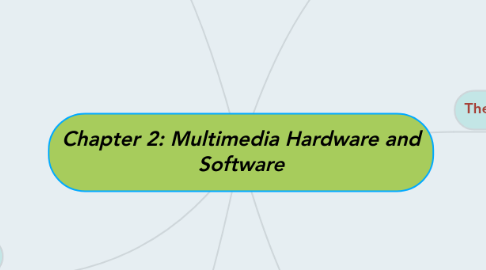
1. Hardware
1.1. Production platforms
1.2. Windows vs. Macintosh
1.3. Connections
1.4. IDE
1.5. USB (Universal Serial Bus)
1.6. FireWire
1.7. Memory and storage devices
1.8. Input devices
1.9. Output devices
2. Software
2.1. ~ Texting editing and word processing tools.
2.2. ~ OCR software
2.3. ~ Painting tools allow to create and modify bitmap images.
2.4. ~ Drawing tools allow to create and modify vector graphics.
2.5. ~ 3-D modeling tools allow rendering of objects in a three-dimensional perspective.
2.6. ~ Image editing tools.
2.7. ~ Sound editing tools.
2.8. ~ Animation, video, and digital movie tools.
3. Authoring Systems
3.1. Types of Authoring Tools
3.1.1. i) Card-and page-based authoring tools - Elements are arranged like pages of a book or cards in a stack. Example: LiveCode
3.1.2. ii) Icon-and object-based authoring tools - Multimedia elements and interaction cues are organized as objects in a flow chart.
3.1.3. iii) Time-based authoring tools - Developer can coordinate the time, speed and display length of each elements. Example: Adobe Flash and Adobe Director
3.2. Objects
3.2.1. - Objects may contain scripts that specify a related action.
3.3. Choosing an authoring tool
3.3.1. a) Editing and organizing features - to create, edit, and convert multimedia elements such as animation and video clips.
3.3.2. b) Programming features - visual programming with icons or objects is the simplest and easiest authoring process. Example: Flash, Livecode & Toolbook.
3.3.3. c) Interactivity features - gives the end user control over the content and flow of information in a project.
3.3.4. d) Performance tuning and playback features - achieving synchronization is difficult, authoring system should facilitate precise timing of events.
3.3.5. e) Delivery features - run time version not allow user to access and change the contents.
3.3.6. f) Cross-platform features - facilitate easy transfer across platforms (example from Macintosh to Windows).
3.3.7. g) Internet-playability features - converting their output to be delivered within the context of HTML or DHTML.
4. Multimedia Development Process
4.1. Planning and costing
4.1.1. · prepare time estimate and a budget.
4.1.2. · prepare a short prototype or proof-of-concept.
4.2. Designing and Producing
4.2.1. · perform each of the planned tasks to create a finished product.
4.3. Testing
4.3.1. - Alpha Testing · The main interest is to review the concept, format, user interface and the layout. · This application may be missing part of the content or functionality.
4.3.2. - Beta Testing · Main interest is to find bugs or content errors. · It is a fully functioning product and should be relative bug free.
4.4. Delivering
4.4.1. · Final stage · Package and deliver the project to the end user. · Be prepared to follow up over time with tweaks, repairs and upgrades.
5. The Intangible assets in Multimedia
5.1. Creativity
5.2. Organization
5.3. Communication
6. Multimedia skills
6.1. a) project mannager
6.1.1. - The leader of a project. - Oversee the entire project.
6.2. b) multimedia designer
6.2.1. - Determines the design elements required to support that structure.
6.3. c) interface designer
6.3.1. - In charge of designing each screen or page interface that lets the user access or modify the content. (simplicity)
6.4. d) writer
6.4.1. - Create characters and actors' narrations. - Write text screens to deliver message.
6.5. e) video/audio specialist
6.5.1. - Focus on the audio and video production : shooting, capturing and editing video, digitizing and audio recording.
6.6. f) multimedia programmers
6.6.1. - Integrate all the elements of the project using an authoring system or programming language.
